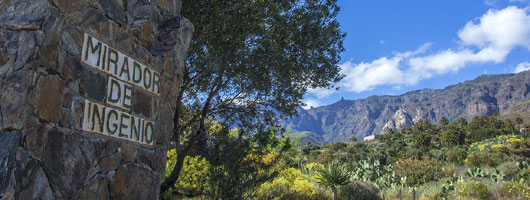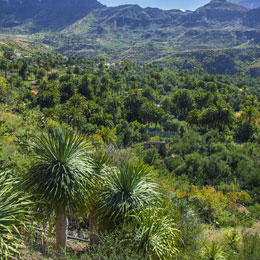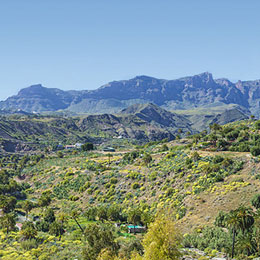This viewpoint is one of the watchtowers providing the finest views over the important basin at the Barranco de Tirajana.
The landscape here is dotted with Canary palm tree groves (Phoenix canariensis), which have played a crucial role in traditional culture in Tirajana, with its direct links with its craft trade. There are large examples of them, together with olive trees, making up swathes of vegetation that evoke a past in which the natural environment was gradually transformed by man as he went in search of natural means of subsistence.

The history of this area is marked by many events which bear testament to its farming past, going back to the historic times of sugar cane production and its sugar mills. Full time dedication to farming is currently dwindling in favor of the development of the ever growing tourist sector. This has allowed locals to emerge from virtual isolation that its rugged terrain even today imposes on them. Many have relocated to coastal areas where tourism has played an important role in the area’s current development.
The countryside we see today was the scene for most of the history which unfolded in the central-southern area of Gran Canaria. Santiago de Tunte however continues to be the place for pilgrimage as it has been for many a year, since a bygone time in which “all paths led to Tunte”.


In the words of French anthropologist René Verneau, who was a regular visitor to Gran Canaria between the end of the 19th century and the beginning of the 20th, the wealth and importance of its resources at the time are reflected in the fact that: “The inhabitants of Tirajana are essentially farmers. It couldn’t be any other way, given the fertility of this valley, which produces an abundance of excellent maize and a wide range of fruits. Its figs and almonds are especially well known around here. Perhaps this is the region in which we can find most of these fine red partridges, so common in the mountains around Gran Canaria”.
The whole area to the west of the Barranco de Tirajana (except from a small strip along the coast) forms part of the World Biosphere Reserve of Gran Canaria, as declared by UNESCO on 29th June 2005.
